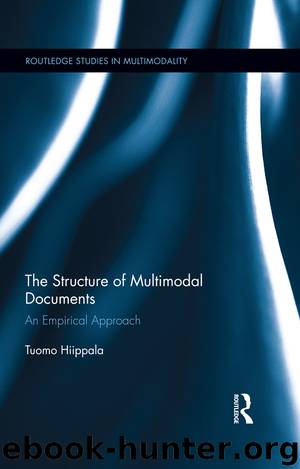The Structure of Multimodal Documents by Tuomo Hiippala

Author:Tuomo Hiippala [Tuomo Hiippala]
Language: eng
Format: epub
ISBN: 9781317580119
Publisher: Taylor & Francis Ltd
6.2 The relationship between medium and advertising
In the consumer society, advertising may be broadly defined as an activity that encourages the consumption of goods, services, and information. It is a multifaceted phenomenon that may be approached from purely economic standpoints, or alternatively, advertising may be described as a series of complex semiotic and psychological operations to persuade both individuals and groups. The word ‘complex’, particularly in connection with the term ‘semiotic’, underlines that advertising is not a simple, straightforward process of communication between the advertiser and the consumer. Instead, advertising pursues its goals through indirect discourse (Crook, 2004; Catenaccio, 2008), across a variety of media (Lemke, 2009; White, 2010, 2012), and most importantly, by using multiple semiotic modes (Cheong, 2004; Hopearuoho and Ventola, 2009; Tan, 2009; Feng, 2011; Martínez Lirola and Chovanec, 2012). Not surprisingly, advertising has been frequently studied within different approaches to multimodality (see e.g. Forceville, 1996; Beasley and Danesi, 2002; Van Mulken, Le Pair and Forceville, 2010; Martínez-Camino and Pérez-Saiz, 2012; Lagerwerf, van Hooijdonk and Korenberg, 2012).
In relation to other fields of study, multimodal research has contributed particularly to an increased understanding of meaning-making in advertising on various levels of abstraction. Royce (1998), Cheong (2004) and Feng (2011), for instance, have provided detailed descriptions and methods for studying print advertisements. On a more abstract level, O’Halloran and Lim (2009) and Berazhny (2012) have contributed broad descriptions of the advertisements in the magazine medium. Again, it is the notion of a medium that brings us to the focal issue. Our knowledge of advertising in the brochure medium remains limited, which presents a challenge for describing the multimodal structure of the tourist brochure: how to relate the advertisements to the content ascribed to ‘genre’?
One solution to meeting this challenge is to consider advertising as a medium-based phenomenon. This acknowledges the contribution of advertising to the multimodal artefact, but separates the advertisements from the genre content. This does not, however, rule out studying specific kinds of advertisements as a genre in other contexts (see e.g. car advertisements in Hopearuoho and Ventola, 2009; Feng, 2011). For the current framework, however, separating the genre content and the advertisements is necessary, because advertising is driven by decisions related to marketing strategies that attempt to reach the potential consumers, who also have an interest in the genre realised in the artefact. The semiotic choices made in the advertisements are of secondary concern and largely differ from the choices made in the genre structure, which this book attempts to uncover. This view will be maintained and elaborated below.
In this view, the advertisements have the potential to be realised in a medium, if the combination of the medium and the genres affords advertising. This constraint needs to be set out clearly, because certain combinations seem to resist advertising. Consider, for instance, factual and fictive genres realised in the book medium. This research monograph, for instance, does not have classified advertisements, except for scholarly purposes in Figure 6.2. This constraint does not, however, prevent all forms of
Download
This site does not store any files on its server. We only index and link to content provided by other sites. Please contact the content providers to delete copyright contents if any and email us, we'll remove relevant links or contents immediately.
Wonder by R.J. Palacio(8435)
Mastering Adobe Animate 2023 - Third Edition by Joseph Labrecque(3727)
Unlabel: Selling You Without Selling Out by Marc Ecko(3577)
Ogilvy on Advertising by David Ogilvy(3490)
Hidden Persuasion: 33 psychological influence techniques in advertising by Marc Andrews & Matthijs van Leeuwen & Rick van Baaren(3458)
Drawing Cutting Edge Anatomy by Christopher Hart(3444)
The Pixar Touch by David A. Price(3352)
POP by Steven Heller(3300)
The Code Book by Simon Singh(3060)
The Art of War Visualized by Jessica Hagy(2934)
Slugfest by Reed Tucker(2928)
The Curated Closet by Anuschka Rees(2902)
Rapid Viz: A New Method for the Rapid Visualization of Ideas by Kurt Hanks & Larry Belliston(2817)
Stacked Decks by The Rotenberg Collection(2799)
365 Days of Wonder by R.J. Palacio(2739)
The Wardrobe Wakeup by Lois Joy Johnson(2723)
Keep Going by Austin Kleon(2684)
Tattoo Art by Doralba Picerno(2589)
Tell Me More by Kelly Corrigan(2581)
